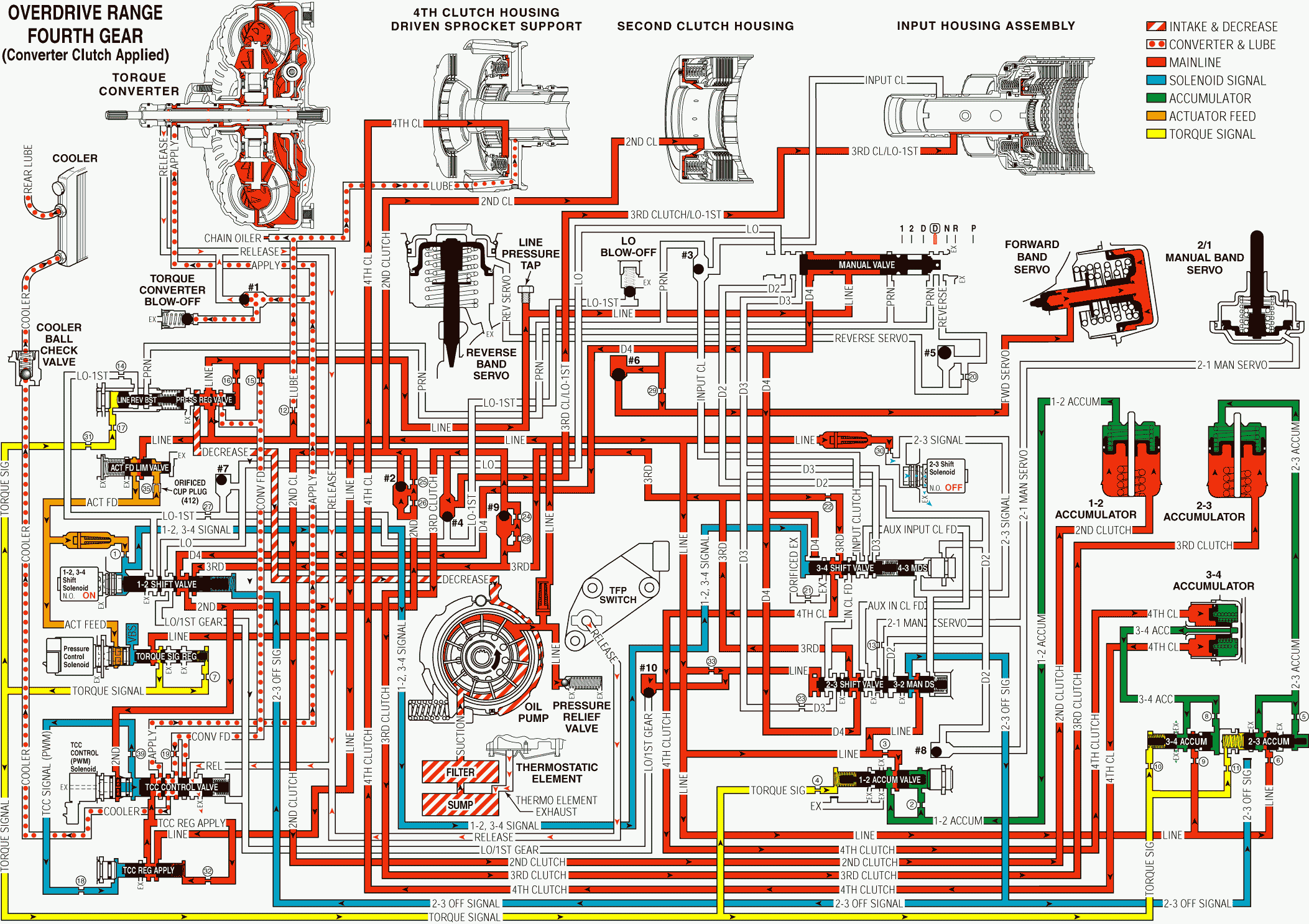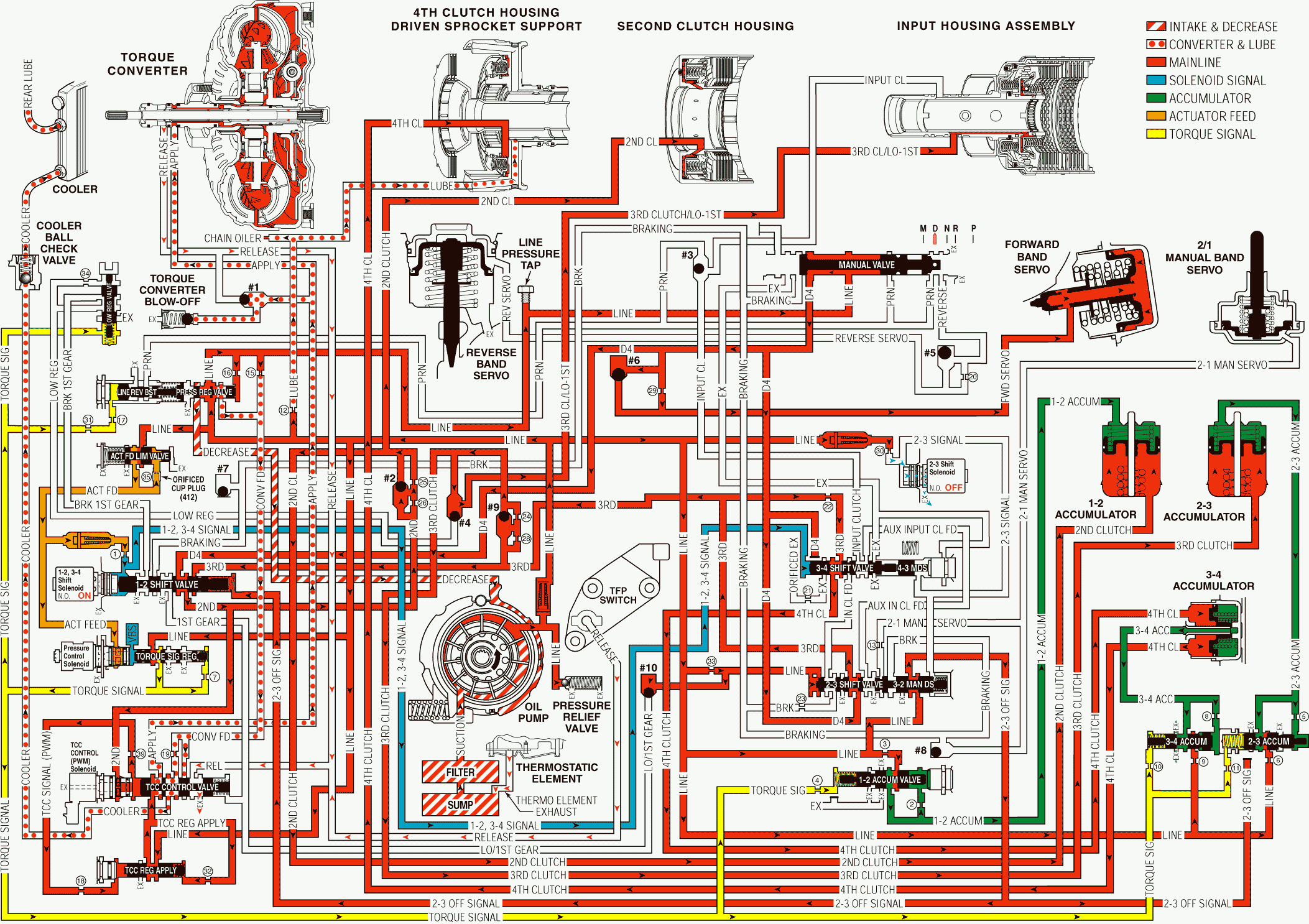Overdrive Range, Fourth Gear - Torque Converter Clutch Applied Without Touch Activated Power
The torque converter clutch applies during third or fourth gear operation after the powertrain control module (PCM) receives the appropriate input signals to energize the TCC control (PWM) solenoid. To apply the torque converter clutch, the following changes take place in the electrical and hydraulic systems:
TCC Control (PWM) Solenoid
When conditions are appropriate, the PCM energizes the TCC control (PWM) solenoid to initiate the TCC apply. The solenoid is pulse width modulated (PWM) to provide a smooth TCC apply (refer to the electrical controls section for a detailed description of the TCC control (PWM) solenoid operation). When energized, the TCC control (PWM) solenoid modulates 2nd fluid into the TCC signal (PWM) fluid circuit.
TCC Regulator Valve
TCC signal (PWM) fluid pressure modulates the valve against spring force and TCC regulated apply fluid pressure. This action directs line pressure into the TCC regulated apply fluid circuit in relation to vehicle operating conditions.
TCC Control Valve
Modulated TCC signal (PWM) fluid pressure moves the valve against spring force in relation to vehicle operating conditions. This action regulates TCC regulated apply fluid into the TCC apply fluid circuit. At the same time, the TCC release fluid circuit is opened to an orificed exhaust. In this position the valve directs converter feed fluid to feed the cooler fluid circuit.
Torque Converter Clutch
TCC apply fluid is routed to the torque converter clutch at the same time TCC release fluid exhausts from the torque converter clutch. TCC apply fluid pressure applies the TCC.
Transmission Fluid Pressure (TFP) Manual Valve Position Switch
Release fluid also exhausts from the TFP manual valve position switch and the TFP manual valve position switch signals the PCM that the TCC is engaged.
Cooler Check Valve
Located in either the case cover or cooler line fitting depending on model. Allows cooler fluid to pass through the cooler and provide lubrication for the transmission. It also prevents converter drainback when the engine is off.
Number 1 Ball Check Valve (372)
Located in the case cover (400), blocks TCC release fluid while sending TCC apply fluid to the torque converter clutch blow-off valve (417-20).
Converter Clutch Blow-off Valve
Limits maximum TCC apply pressure to prevent torque converter damage.
Overdrive Range, Fourth Gear - TCC Applied - Without Touch Activated Power

Overdrive Range, Fourth Gear - Torque Converter Clutch Applied With Touch Activated Power
The torque converter clutch applies during third or fourth gear operation after the powertrain control module (PCM) receives the appropriate input signals to energize the TCC control (PWM) solenoid. To apply the torque converter clutch, the following changes take place in the electrical and hydraulic systems:
TCC Control (PWM) Solenoid
When conditions are appropriate, the PCM energizes the TCC control (PWM) solenoid to initiate the TCC apply. The solenoid is pulse width modulated (PWM) to provide a smooth TCC apply (refer to the electrical controls section for a detailed description of the TCC control (PWM) solenoid operation). When energized, the TCC control (PWM) solenoid modulates 2nd fluid into the TCC signal (PWM) fluid circuit.
TCC Regulator Valve
TCC signal (PWM) fluid pressure modulates the valve against spring force and TCC regulated apply fluid pressure. This action directs line pressure into the TCC regulated apply fluid circuit in relation to vehicle operating conditions.
TCC Control Valve
Modulated TCC signal (PWM) fluid pressure moves the valve against spring force in relation to vehicle operating conditions. This action regulates TCC regulated apply fluid into the TCC apply fluid circuit. At the same time, the TCC release fluid circuit is opened to an orificed exhaust. In this position the valve directs converter feed fluid to feed the cooler fluid circuit.
Torque Converter Clutch
TCC apply fluid is routed to the torque converter clutch at the same time TCC release fluid exhausts from the torque converter clutch. TCC apply fluid pressure applies the TCC.
Transmission Fluid Pressure (TFP) Manual Valve Position Switch
Release fluid also exhausts from the TFP manual valve position switch and the TFP manual valve position switch signals the PCM that the TCC is engaged.
Cooler Check Valve
Located in either the case cover or cooler line fitting depending on model. Allows cooler fluid to pass through the cooler and provide lubrication for the transmission. It also prevents converter drainback when the engine is off.
Number 1 Ball Check Valve (372)
Located in the case cover (400), blocks TCC release fluid while sending TCC apply fluid to the torque converter clutch blow-off valve (417-20).
Converter Clutch Blow-off Valve
Limits maximum TCC apply pressure to prevent torque converter damage.
Overdrive Range, Fourth Gear - TCC Applied - With Touch Activated Power

The torque converter clutch (TCC) applies during third or fourth gear operation after the powertrain control module (PCM) receives the appropriate input signals to energize the TCC control (PWM) solenoid. To apply the torque converter clutch, the following changes take place in the electrical and hydraulic systems:
TCC Control PWM Solenoid
When conditions are appropriate, the PCM energizes the TCC control (PWM) solenoid to initiate the TCC apply. The solenoid is pulse width modulated (PWM) to provide a smooth TCC apply (refer to the electrical controls section for a detailed description of the TCC control (PWM) solenoid operation). When energized, the TCC control (PWM) solenoid modulates 2nd fluid into the TCC signal (PWM) fluid circuit.
TCC Regulator Valve
TCC signal (PWM) fluid pressure modulates the valve against spring force and TCC regulated apply fluid pressure. This action directs line pressure into the TCC regulated apply fluid circuit in relation to vehicle operating conditions.
TCC Control Valve
Modulated TCC signal (PWM) fluid pressure moves the valve against spring force in relation to vehicle operating conditions. This action regulates TCC regulated apply fluid into the TCC apply fluid circuit. At the same time, the TCC release fluid circuit is opened to an orificed exhaust. In this position the valve directs converter feed fluid to feed the cooler fluid circuit.
Torque Converter Clutch
TCC apply fluid is routed to the torque converter clutch at the same time TCC release fluid exhausts from the torque converter clutch. TCC apply fluid pressure applies the TCC.
Transmission Fluid Pressure (TFP) Manual Valve Position Switch
Release fluid also exhausts from the TFP manual valve position switch and the TFP manual valve position switch signals the PCM that the TCC is engaged.
Cooler Check Valve
Located in either the case cover or cooler line fitting depending on model. Allows cooler fluid to pass through the cooler and provide lubrication for the transmission. It also prevents converter drainback when the engine is off.
Number 1 Ball Check Valve (372)
Located in the case cover (400), blocks TCC release fluid while sending TCC apply fluid to the torque converter clutch blow-off valve (417-20).
Converter Clutch Blow-off Valve
Limits maximum TCC apply pressure to prevent torque converter damage.
Overdrive Range, Fourth Gear - TCC Applied

